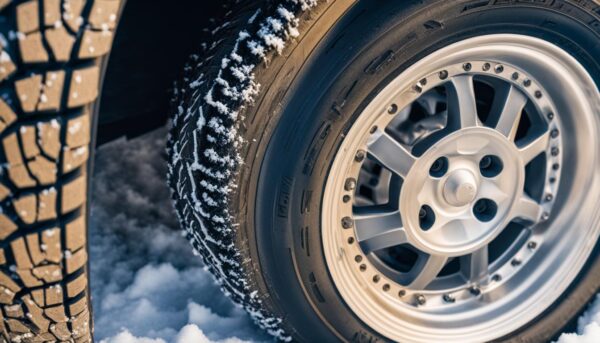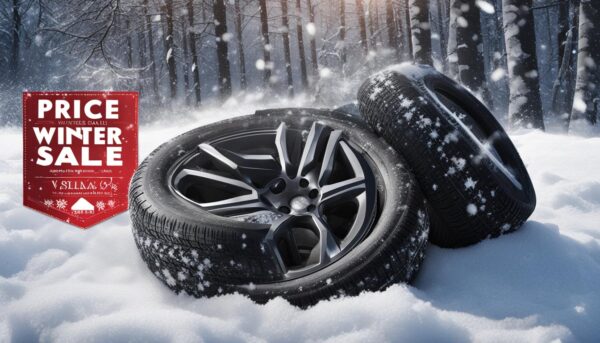Last Updated on 4 months
Your Complete Guide to Choosing and Using Winter Tires Effectively
Winter driving can be a daunting experience, especially when faced with icy roads and freezing temperatures. Ensuring your vehicle is well-equipped to handle these conditions is essential for safe driving, and investing in winter tires is a critical component of that preparation. In this article, we’ll discuss the benefits of winter tires, how they differ from all-season tires, and how to select, install, and maintain them to optimize their performance and your vehicle’s safety.
Key Takeaways
- Winter tires have unique tread patterns and rubber compounds to improve traction and handling on icy and cold roads.
- Switching to winter tires at the right time is essential for maintaining optimal vehicle performance and safety during colder months.
- Understanding the specific features of winter tires, such as tread patterns and rubber compounds, is vital when selecting the best tires for your vehicle.
- Proper installation and storage are crucial for maintaining the safety and lifespan of your winter tires.
- Regular tire pressure checks and balances are necessary to ensure your winter tires’ consistent and safe performance.
- Comparing studded vs. studless winter tires will help you decide which option is best suited for your specific driving conditions.
- Familiarize yourself with the best times and strategies to find winter tire sales and deals, ensuring you get the best value for your investment.
Understanding Winter Tires and Their Importance
Winter tires, also known as snow tires, cold weather tires, or ice tires, are critical to safe driving on slippery, icy, and snow-covered roads. They are designed to provide enhanced traction and handling in freezing temperatures, setting them apart from standard all-season tires. In this section, we will discuss the unique features of winter tires and dig into the safety statistics, demonstrating their importance in accident prevention.
What Makes Winter Tires Different
Thanks to their distinct tread patterns, rubber compounds, and deeper grooves, winter tires are tailored to meet the challenges of driving in cold weather conditions. The specific design of snow tires allows them to maintain flexibility even in extremely low temperatures, ensuring they can grip the road and provide enhanced traction.
- Tread Patterns: The tread patterns on winter tires are engineered to push snow and water out from under the contact patch, ensuring improved traction and handling on slippery surfaces. They also feature a high number of “sipes,” which are small slits that create additional biting edges for better grip on snow and ice.
- Rubber Compounds: Winter tires use unique rubber compounds that remain soft and flexible in cold temperatures, allowing them to maintain traction over packed snow and icy roads. In comparison, all-season tires often stiffen and lose grip under similar conditions.
- Deeper Grooves: With deeper grooves than all-season tires, winter tires can clear more snow, slush, and water from the contact patch, preventing buildup and enabling better grip on slick surfaces.
Statistical Safety Benefits of Using Winter Tires
Winter tires provide multiple safety benefits that reduce vehicular accidents in adverse weather conditions. Up to 17% of vehicle crashes occur in winter weather conditions, making it crucial for drivers to opt for the right tires. Studies and real-world observations demonstrate the effectiveness of winter tires in accident prevention and enhanced vehicle control.
| Key Safety Benefit | Percentage Improvement with Winter Tires |
|---|---|
| Stopping Distance on Snow | 20-30% |
| Cornering Grip on Ice | 15-30% |
| Traction in Snow | 20-30% |
| Braking Distance on Ice | 25% |
“The superior performance of winter tires not only provides drivers with increased confidence on the road but also significantly reduces the risk of accidents.”
By offering better grip and handling in cold weather conditions, winter tires significantly contribute to overall road safety. Equipping your vehicle with the appropriate tires for icy and snowy conditions is essential in protecting yourself and others on the road during winter.
The Best Time to Switch to Winter Tires
Knowing the optimal timing to install winter tires improves your vehicle’s performance and safety and ensures you get the most out of your investment. Delaying the switch to winter-appropriate tires can significantly increase the risks associated with winter driving. This guide is a reference to help you determine the best time to switch.
Temperature Thresholds are crucial in deciding when to mount winter tires on your vehicle. As the air starts to cool down and the temperature consistently remains below 45°F (7°C), it’s time to consider installing winter tires. Standard all-season tires lose their grip and flexibility when the mercury dips below this critical threshold.
Waiting for the first snowfall to install winter tires is not advisable since temperatures drop much earlier in the season, and the risks associated with cold-weather driving can already be present. Adapting to the icy, snowy conditions requires foresight and preparation; planning well before the winter season begins ensures your winter driving safety.
Keep in mind that, on average, the first snowfall in the United States occurs between October and December, depending on geographical locations and local climates. Always plan and make necessary preparations in advance to avoid last-minute challenges and risks associated with winter roads.
- Regular Maintenance and Inspection: An essential aspect of installing winter tires is conducting routine checks on your tires’ tread depth and condition. Equally important is proper inflation, as under-inflated tires can compromise your safety even with winter-appropriate tire technology.
- Take Note of Climate Patterns: Geographical areas with earlier or prolonged winter conditions may warrant an earlier switch to winter tires. Make a habit of monitoring the local weather conditions and react to patterns accordingly.
- Consider High-Quality Tires: Ensuring that your winter tires are of high quality and in excellent condition guarantees your safety and protects your investment in the long run by ensuring prolonged and reliable performance.
Armed with the knowledge of temperature thresholds, climate patterns, and sound tire management, deciding the best time to install winter tires should be a more manageable and informed process. Making the switch at an optimal time is a small step with significant benefits for winter driving safety.
Features to Look for in the Best Winter Tires
When selecting the best winter tires for your vehicle, it’s essential to consider the features that make snow tires perform well in cold, icy, and snowy conditions. This section will discuss two critical factors to look for: tread patterns and depth and rubber compounds suited for the cold.
Tread Patterns and Depth
One of the most essential features to look for in snow tires is their tread pattern and depth. Winter tires have specially designed tread patterns and deep grooves that enhance traction, provide superior grip, and prevent snow buildup, ensuring optimal performance in challenging conditions.
Did you know? Deeper grooves in winter tires help expel water, slush, and snow, while unique tread patterns such as sipes provide added grip on icy and slippery surfaces.
When comparing tread patterns, pay attention to the presence of sipes, which are small slits in the treads that improve traction on icy surfaces. These intricate patterns work together with deep grooves to deliver enhanced grip and control on snow and ice-covered roads.
Rubber Compounds Suited for the Cold
Another critical feature to consider when choosing winter tires is the winter tire rubber compounds. Unlike all-season tire rubber, winter tires are specifically formulated to maintain cold weather flexibility, ensuring consistent traction and handling on icy roads.
Winter tires incorporate unique rubber compounds with more natural rubber, silica, and other additives to prevent the rubber from hardening in freezing temperatures. This allows the tire to remain flexible and firmly grip icy and snow-covered surfaces.
Remember: Rubber compounds in ice tires must remain flexible even in extreme cold to provide enhanced grip and performance on winter roads.
In conclusion, when shopping for winter tires, focus on identifying products with deep grooves and specialized tread patterns that maximize traction, grip, and stability. Additionally, ensure the tires feature rubber compounds designed to maintain flexibility in cold weather, offering reliable performance regardless of the harsh winter conditions. By prioritizing these essential features, you’ll be better equipped to select the right snow tires for your needs and improve your driving safety in winter.
The Role of Tire Pressure in Winter Tire Performance
Proper tire pressure plays a significant role in the performance and safety of your winter tires. Cold temperatures can cause pressure fluctuations, influencing how your vehicle handles on icy roads and consequently impacting your safety. Keeping an eye on your tires’ pressure and maintaining their optimal inflation is essential during winter.
Low tire pressure can result in reduced traction, less responsive steering, and decreased fuel efficiency. On the other hand, overinflating your winter tires can lead to uneven wear and a higher risk of tire damage. To ensure optimal performance and safety, follow the tire pressure recommendations from your vehicle’s manufacturer.
“Cold temperatures can cause the PSI (pound per square inch) in your tires to drop. For every 10 degrees Fahrenheit decrease in temperature, your tire’s pressure can drop about 1 PSI.” – Popular Mechanics
As the temperature drops, checking your tire pressure and making necessary adjustments regularly is crucial. Here are some tips to properly maintain your winter tires:
- During drastic temperature fluctuations, check your tire pressure at least once a month or more.
- Use a reliable tire pressure gauge to measure your tire pressure accurately.
- Follow your vehicle manufacturer’s recommendations for proper tire inflation based on the specific winter tires you’re using.
- Always check your tire pressure when the tires are cold, preferably in the morning before driving, to obtain an accurate reading.
Correctly maintaining your winter tire pressure enhances vehicle performance on icy roads and prolongs the life of your winter tires. Keeping a close eye on tire inflation ensures a safer and more enjoyable driving experience during the cold months.
How to Properly Maintain Your Winter Tires
Winter tire maintenance is essential for ensuring optimal performance, extending the lifespan of your snow tires, and maintaining safety on icy roads. This section will provide valuable tips and information on the best storage solutions for off-season tire care and the importance of regular checks and tire balancing.
Storage Solutions for Off-season
Proper winter tire storage is crucial to protect your tires and ensure they remain in optimal condition for subsequent use. Storing them improperly can cause damage, affecting their performance and safety when you need them the most. Consider the following off-season tire care tips:
- Ensure tires are clean before storage, as dirt and grime can cause the rubber to deteriorate over time.
- Store tires in a cool, dry, and dark environment to prevent exposure to sunlight, heat, and moisture, which can negatively impact the tire compounds and structure.
- Stack tires horizontally or hang them on a rack designed explicitly for tire storage to prevent deformation.
- Consider using tire storage bags or protective covers to guard against dirt, dust, and moisture penetration.
Regular Checks and Balancing
Performing regular checks and balancing your winter tires is essential for retaining their performance and extending their life. Implement the following maintenance tips to ensure effective handling and safety:
- Inspect tire tread depth regularly to ensure it meets the minimum legal requirement and provides adequate traction in icy conditions.
- Monitor tire pressure since cold temperatures can cause fluctuations that affect vehicle handling. Adjust the pressure according to the manufacturer’s recommendations.
- Check for signs of tire damage, such as punctures, sidewall bulges, or uneven wear patterns, which may impair performance and necessitate tire replacement.
- Perform tire balancing to prevent uneven wear, promote smooth rides, and extend tire life. It is typically recommended to balance your tires every 6,000 to 8,000 miles or when you notice anything unusual during driving.
Remember, consistent winter tire maintenance is key to ensuring a reliable and safe driving experience in cold weather conditions. By following these off-season tire care and regular check tips, you’ll significantly lower the risk of accidents and extend the lifespan of your snow tires.
Winter Tire Comparison: Studs vs. Studless

When choosing the right winter tire for your vehicle, it is essential to understand the differences between studded winter tires and studless snow tires. Both tires offer excellent performance on ice and snow, but there are notable distinctions in their traction capabilities and the road surface impact. This section compares studded and studless winter tires, helping you decide on your driving needs.
Traction Comparison
Depending on the winter conditions you experience, the traction offered by studded and studless tires can vary. To better understand the traction capabilities of both tires, let’s explore their performance in different circumstances:
- Ice Gripping: Studded tires provide superior ice gripping capability due to the metal studs embedded in the tire, allowing for better traction on icy surfaces. In contrast, studless tires rely on specialized rubber compounds and tread patterns to grip icy roads, which may not be as effective as metal studs in certain conditions.
- Snow Traction: Both studded and studless tires perform well in deep snow; however, modern studless snow tires have significantly advanced snow traction, often matching or outperforming studded tires in snowy conditions.
- Dry and Wet Road Traction: Studless snow tires have better overall traction and handling on dry or wet pavement due to their advanced rubber compounds and lack of metal studs that can reduce traction on non-icy surfaces.
Road Surface Impact
Another essential factor when choosing between studded winter tires and studless snow tires is the impact on road surfaces. Due to their metal studs, studded tires can cause increased wear and damage to road surfaces and are noisier when driving on dry or wet pavements. For this reason, some states have restrictions or prohibitions on studded tire use.
Check your local laws and regulations before purchasing studded winter tires to ensure they are allowed in your region.
| Studded Winter Tires | Studless Snow Tires |
|---|---|
| Superior ice-gripping capability | It relies on rubber compounds and tread patterns for ice traction |
| Good performance in deep snow | Advanced snow traction often matches or outperforms studded tires |
| Reduced dry and wet road traction | Better overall traction and handling on dry and wet pavement |
| Potential road damage and increased noise | Minimal road impact and quieter performance |
| It may be subject to usage restrictions | Allowed in all states |
In conclusion, both studded winter tires and studless snow tires offer their advantages and drawbacks. When choosing between the two, consider the winter conditions you typically experience, and be aware of any usage restrictions in your area. Selecting the right winter tire will give you the traction and safety your vehicle needs for a secure and comfortable winter driving experience.
A Step-by-Step Guide to Installing Winter Tires
Installing winter tires ensures your vehicle’s safety and optimal performance on snowy and icy roads. This step-by-step guide will help you through the process of installing snow tires correctly and safely. Follow these steps and tips to make your winter tire installation a seamless experience.
- Choose the right winter tires for your vehicle: Ensure you have the correct size and type before installing. Consult your owner’s manual or a trusted tire professional for recommendations.
- Gather the necessary tools and equipment: Gather all the required tools and equipment for the installation process, including a jack, jack stands, lug wrench or tire iron, torque wrench, and wheel chocks to secure your vehicle.
- Secure your vehicle: Park on a flat, stable surface with enough space to work. Engage the parking brake and place wheel chocks on the wheels opposite to the ones you will be working on to ensure the vehicle does not move during installation.
- Loosen the nuts: Using your lug wrench or tire iron, loosen the nuts on the wheels you’ll be working on. Do not entirely remove the lug nuts at this stage.
- Jack up your vehicle: Following your owner’s manual instructions, properly jack up your vehicle and place jack stands underneath the frame for added security. Ensure the car is stable before proceeding.
- Remove the current tires: Fully remove the lug nuts and then carefully remove the tires from the vehicle.
- Mount the winter tires: Align the holes on the tires with the holes on the wheel hub, and start sliding the tire onto the seat. Make sure the valve stem is facing outward.
- Secure the winter tires: Reattach the nuts using your lug wrench or tire iron. Tighten them in a star pattern to ensure an even distribution of pressure.
- Lower your vehicle and tighten the lug nuts: Remove the jack stands and carefully lower your car using the jack. Once the vehicle is back on the ground, use your torque wrench and tighten the lug nuts according to the manufacturer’s recommendations.
- Check the tire pressure and balance: Inflate the winter tires to the recommended pressure in your owner’s manual or the vehicle’s tire placard. Have the tires balanced at a professional shop to ensure proper alignment and even wear if necessary?
After completing the winter tire installation process, test your vehicle’s performance on a safe, controlled surface and confirm that the tires are functioning as expected. Keep an eye on the tire pressure during winter, as cold temperatures can cause fluctuations, and maintain proper inflation levels for optimal performance and safety.
Where to Find the Best Winter Tire Sales and Deals

Winter can be challenging for road users, and having the right equipment is essential to ensure your safety. Investing in winter tires is bright, but it doesn’t have to break the bank. With some research and timing, you can find the best winter tire sales and tire deals to get affordable winter tires for your vehicle. This section will highlight the best times of the year and specific strategies for securing the best winter tire prices.
“The early bird catches the worm.”
As the saying goes, early birds can save on winter tires. Most dealerships and tire retailers begin to offer deals on winter tires towards the end of summer and the beginning of fall. This is a great time to start looking for winter tire sales, as businesses are stocking up on inventory and looking to move old stock in preparation for the new season.
Another prime time to score affordable winter tires is during Black Friday and Cyber Monday sales. During this hugely popular shopping season, retailers often slash prices on all sorts of items, including winter tires. If you’re looking for the best winter tire prices, you’ll want to monitor your favorite retailers and online shopping sites for exclusive deals and limited-time offers.
Clearance sales can also be an excellent opportunity to find great tire deals. Sometimes, these sales occur at the end of winter or shortly before new tire models are released. Watch for clearance events and be prepared to act quickly, as stock may be limited.
- Start shopping towards the end of summer or early fall
- Look for deals during the Black Friday and Cyber Monday period
- Monitor clearance sales at the end of winter or before new tire releases
Price comparison websites and shopping apps can be valuable resources for finding the best winter tire prices. By comparing prices from different retailers, you can ensure that you get the best possible deal on your desired set of winter tires. Some of these resources may even offer exclusive discounts and cashback opportunities to save you even more money.
| Retailer | Estimated Sale Period |
|---|---|
| Tire Rack | End of summer/fall, Black Friday & Cyber Monday |
| Discount Tire Direct | Black Friday & Cyber Monday |
| Walmart | End of summer/fall, Black Friday & Cyber Monday |
Finally, don’t forget the power of negotiation. In-person tire retailers may be willing to match or beat competitor prices, so it’s crucial to be informed on current market prices before entering any negotiations. Shopping around and taking advantage of seasonal sales, online discounts, and clearance events will ensure you get the best value when purchasing winter tires.
Conclusion
As explored throughout this article, winter driving safety is paramount when navigating cold and icy roads. Choosing the right winter tires is critical in ensuring your vehicle’s performance and safety during the colder months. With the proper knowledge of tire construction, tread patterns, rubber compounds, and maintenance tips, you can confidently decide on the ideal tires for your specific needs.
Remember that not only do winter tires offer enhanced traction and control in harsh winter conditions, but they also contribute to a decrease in vehicular accidents. Be mindful of the optimal time to switch to winter tires, and never underestimate the significance of tire pressure and regular maintenance in preserving their performance.
In conclusion, driving in winter weather demands extra care and attention from drivers across the United States. By following the tips and advice shared in this article, you will be well-equipped to tackle all sorts of winter road challenges safely and securely. Stay safe, and enjoy the journey!
FAQ
What makes winter tires different from all-season tires?
Winter tires, also known as snow or cold weather tires, are designed with unique tread patterns, deeper grooves, and special rubber compounds that remain flexible in low temperatures. Compared to standard all-season tires, these features improve traction and performance on icy, snowy, or cold roads.
How do winter tires contribute to safer driving in cold weather?
Winter tires provide superior grip and handling on icy or snowy roads, reducing the risk of accidents. Statistics show that up to 17% of vehicle crashes occur in winter weather conditions, and using winter tires can help mitigate this risk by offering enhanced traction and control.
When should I switch to winter tires?
Switching to winter tires is recommended when temperatures consistently drop below 45°F (7°C) or when winter weather conditions, such as snow and ice, are expected. Waiting too long to install winter tires can compromise your vehicle’s performance and safety on cold roads.
What features should I look for when buying winter tires?
Look for winter tires with deep tread patterns and grooves designed to enhance traction and prevent snow buildup. Additionally, ensure the tires have rubber compounds that retain flexibility in cold temperatures for consistent traction and handling on icy roads.
How does tire pressure affect winter tire performance?
Maintaining correct tire pressure in winter tires is crucial, as cold weather can cause pressure fluctuations that affect vehicle handling and safety on icy roads. Regularly check and adjust your tire pressure according to the manufacturer’s recommendations to ensure optimal performance.
What is the difference between studded and studless winter tires?
Studded winter tires have metal studs embedded in the tread, enhancing traction on icy roads. However, they can damage road surfaces and are restricted in some areas. Studless winter tires use advanced rubber compounds and tread design to provide superior grip on ice and snow without studs. Each type of tire has its benefits and limitations, making it essential to consider the specific conditions you’ll be driving in before making a choice.
How can I find the best winter tire sales and deals?
The best time to find winter tire sales and deals is during off-peak seasons, such as late spring and summer. Additionally, watch manufacturer-sponsored promotions and specials at local tire retailers. Comparing prices and reviews online can also help you find the best deals on winter tires.
Source Links
- https://www.tires-easy.com/blog/category/winter-tires/page/2/












